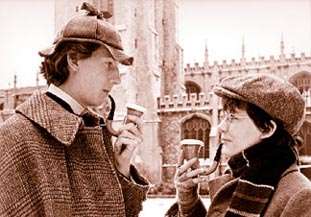Young Sherlock Holmes

A 1985 mystery/adventure film directed by Barry Levinson, produced by Steven Spielberg and written by Chris Columbus, it was based on characters by Sir Arthur Conan Doyle. The movie depicts a young Sherlock Holmes and John Watson meeting and solving a mystery together at a boarding school.
It was the first film produced by Amblin Entertainment to receive a PG-13 rating. The film is notable for including the first fully computer-generated character, a knight composed of elements from a stained glass window. The effect was created by Lucasfilm's John Lasseter, who is now chief creative officer at Pixar Animation Studios and Walt Disney Animation Studios. The SFX earned the film an Academy Award nomination, and was beaten by Cocoon.
Tropes used in Young Sherlock Holmes include:
- Already Met Everyone
- Bittersweet Ending: The two heroes win the day, but Elizabeth dies.
- Blow Gun: An assassin uses a blowgun to shoot darts tipped with a hallucinogenic drug.
- Boarding School
- Cool School: Being cool is what Brompton Academy became.
- Dawson Casting: Nicholas Rowe, who plays Sherlock Holmes, is several years older than most of the other actors playing students. This was probably intentional to give Holmes his necessary height and appearance of superior intellect.
- Disney Villain Death: Rathe falls into a frozen river.
- Everyone Went to School Together: Holmes and Watson go to school together. For more, see The Stinger.
- Flanderization: This film does use the Flanderized version of Watson who's overweight and rather clueless, but it's somewhat Justified by being Watson as a schoolboy. Presumably he's got years (and a stint in the military) yet to grow into the more fit and savvy Watson the original was.
- Force Feeding: The sequence where John Watson hallucinates that his legs are bound with sausages and that pastries are trying to force him to eat them. On YouTube here.
- Freudian Excuse: For both Holmes' detective career (see Troubled Backstory Flashback) and being a bachelor (his first love dies).
- Fright Deathtrap: The Run To Your Doom variety is used frequently in Young Sherlock Holmes, as several elder gentlemen who pissed off the wrong Egyptian cult as younger men are drugged with blow-darts, causing them to see terrifying hallucinations and run into traffic, leap out 3rd story windows, etc.
- I'm Going for a Closer Look: While exploring the hidden temple.
- Mummy Wrap: The cult does this to prepare their victims for sacrifice.
- Mushroom Samba: The peculiar way the victims are killed.
- Mythology Gag: Plenty of them.
- Red Eyes, Take Warning: When the gargoyle in the shop starts to animate, its eyes glow red.
- Sequel Hook: The Stinger reveals that one of the characters in the film would eventually become Professor Moriarty. Shame that there was no sequel (beyond the books, of course), because the flick wasn't that bad.
- Sherlock Scan: A school-aged Watson transfers to a new boarding school and meets Holmes for the first time. Holmes deduces Watson's name, home county, father's occupation, and Watson's love of writing and pastries. He only gets Watson's name wrong (he guesses James instead of John) because he only saw "J. Watson" on Watson's luggage and decided to go with a common name starting with J (John would have been his second guess).
- Sdrawkcab Name: Villain Eh Tar uses the alias of Professor Rathe for his cover job at Brompton Academy. Watson even spells this out towards the end of the film as a "very important clue."
- Spinoff Babies: A pastiche supposedly telling the early life of Holmes and Watson when they first met as teens -- and apparently before Holmes figured out how to solve crimes by logical deduction.
- Perhaps to pacify any purists, Watson's opening narration implies that the whole film may simply be him imagining what it would have been like if he and Holmes met as youngsters. Essentially, it's Watson's High School AU fanfiction about himself and his friend.
- Taking the Bullet: Elizabeth.
- The Eyes Have It: The scene where the knight in the stained-glass window leaps down to do combat with the poor priest. Notable because it is specifically later revealed, like other deaths in the film, to be caused by a hallucinogenic drug. What the priest saw was in fact all in his mind, but since it made him flee the church and run under the wheels of a moving carriage, he still ended up just as dead.
- The Jimmy Hart Version: The cultists performing a human sacrifice chant a song which rips off "O Fortuna" from Carmen Burana.
- The Stinger: The end credits are played over a sleigh going through a snow-covered forest. As the credits end, someone gets out of the sleigh and checks into the hotel. We see him signing in under the name Moriarty. As the camera pans up, Moriarty is revealed to be Ehtar, the villain, who survived the fall into the river.
- Those Magnificent Flying Machines
- Troubled Backstory Flashback: Holmes' drugged hallucination starts out as one of these, with his father yelling at him while his mother weeps in the background. It's implied that Sherlock's snooping uncovered Holmes Sr.'s affair or other transgression, breaking his mother's heart and earning his father's wrath.
- What If: The movie begins with a disclaimer explaining that it's a "What If" story.
This article is issued from Allthetropes. The text is licensed under Creative Commons - Attribution - Sharealike. Additional terms may apply for the media files.